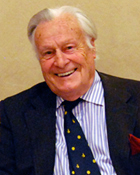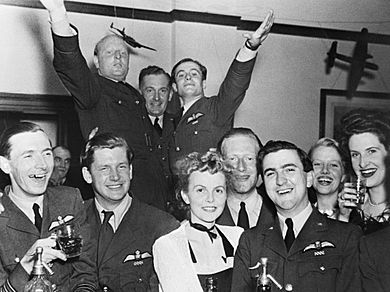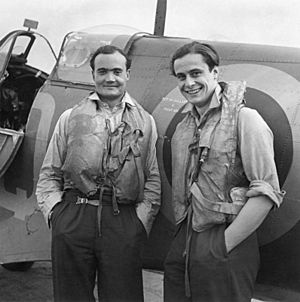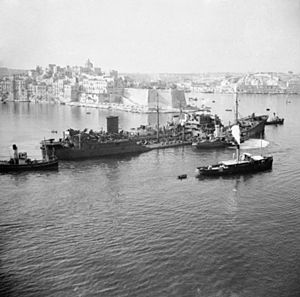Geoffrey Wellum facts for kids
Quick facts for kids
Geoffrey Wellum
|
|
|---|---|

Geoffrey Wellum in 2009
|
|
| Birth name | Geoffrey Harry Augustus Wellum |
| Born | 4 August 1921 Walthamstow, England |
| Died | 18 July 2018 (aged 96) Mullion, England |
| Allegiance | |
| Service/ |
|
| Years of service | 1939–1961, |
| Rank | Squadron Leader |
| Service number | 42925 |
| Battles/wars | Battle of Britain |
| Awards | Distinguished Flying Cross |
Squadron Leader Geoffrey Harris Augustus Wellum DFC (born August 4, 1921 – died July 18, 2018) was a British fighter pilot and writer. He is best known for his brave actions during the Battle of Britain.
Geoffrey was born in Walthamstow, Essex, England. He was an only child. He went to Forest School before joining the RAF. After the war, he stayed in the RAF until 1961. Later, he ran a business that moved goods. He retired in the mid-1980s and moved to Mullion, Cornwall. There, he wrote down his memories from the war. In 2002, these memories were published as a book called First Light.
Contents
Growing Up
Geoffrey Wellum was born on August 4, 1921. His parents were Percy and Edith Wellum. His father had fought in World War I. Geoffrey went to Forest School in Snaresbrook. He was even the captain of the school cricket team.
His Time in the Air Force
World War II Hero
Joining the RAF (1939-1940)
When he was 18, Geoffrey Wellum joined the Royal Air Force in August 1939. His first plane was the Tiger Moth. He flew it at Desford airfield. Geoffrey's first solo flight was on September 1, 1939. Just two days later, Britain declared war on Germany. After his first training, he learned to fly the North American Harvard plane.
In May 1940, Wellum joined 92 Squadron. This was a fighting squadron that flew Spitfires. He flew a Spitfire for the very first time with this squadron. He later wrote that flying it felt "like one of those wonderful dreams."
Wellum's first leader was Roger Bushell. Bushell was captured soon after Wellum arrived. He sadly died later. Wellum remembered thinking, "This is really dangerous!"
After the events at Dunkirk, 92 Squadron moved to RAF Pembrey in Wales. There, Wellum began his combat flights. He chased German planes across the south-west of England.
Wellum fought a lot during the Battle of Britain. Even though he was only 18, he was not the youngest pilot. His friends called him "Boy." On September 9, 1940, 92 Squadron moved to RAF Biggin Hill in Kent. This was right in the middle of the heavy fighting.
Wellum's close friend was Brian Kingcome.

Front row, (left to right): Wg Cdr John A. Kent, Flt Lt Anthony Bartley, Mrs Wade, Flt Lt Robert Holland, Plt Off Trevor Wade and two unidentified ladies. In the back – Plt Off Sebastian Maitland-Thompson, Fg Off Tom Wiesse and Fg Off Geoffrey Wellum.
Wellum shot down a Heinkel He 111 on September 11, 1940. He also shared in shooting down a Junkers Ju 88 on September 27, 1940. He damaged two (and shared in damaging one) Messerschmitt Bf 109s in November 1940.
Fighting Over France (1941)
In the summer of 1941, Wellum flew over 50 missions over France. These missions were called "sweeps." He flew escort for Blenheim and Stirling bombers. This helped take the fight to the enemy. He shot down a Bf 109 over France on July 9, 1941. In August 1941, Wellum received the Distinguished Flying Cross. This award was for his bravery.
By this time, most of Wellum's friends from 92 Squadron had been lost. He survived because of luck and his flying skills. He later said, "Never stay still, never fly straight and level, chuck it around."
In the summer of 1941, Wellum stopped active combat duty. He was sent to a training squadron at Aston Down. There, he flew Hawker Hurricanes. He was sad to leave the front lines at first. But he soon began to enjoy teaching new pilots.
Malta Mission (1942)
In February 1942, he returned to combat. He joined 65 Squadron at Debden. He became a Flight Commander in March 1942. By now, the German air force had a new plane called the Focke-Wulf Fw 190. This plane was faster than the Spitfire V. Wellum's squadron lost many planes. In a fight over France, his wingman, Freddie Haskett, was sadly lost. Wellum himself barely survived. He started to get very bad headaches.
In July 1942, Wellum went to Glasgow. He took part in Operation Pedestal. This was a mission to bring supplies to the island of Malta. Malta was under attack. Wellum led eight Spitfires on the aircraft carrier HMS Furious. They sailed from Scotland to the Mediterranean Sea. On August 11, 1942, Wellum landed his Spitfires on Malta. He joined 145 Squadron to help defend the island.
The supply convoy was heavily attacked. Many ships were sunk. Wellum saw the few remaining ships arrive at Valletta Harbour. The oil tanker SS Ohio, barely floating, arrived last. The people of Malta were silent and respectful as it came in.
On Malta, Wellum was diagnosed with severe sinus issues. He also had exhaustion from three years of intense flying. After surgery, he returned to Britain. He then became a test pilot for new planes. These included the Hawker Typhoon fighter-bomber.
End of the War (1943)
After returning to England, Wellum did not go back to combat. He finished the war as an instructor. In 1943, he married Grace Neil. They had three children together.
Wellum felt that his best years were during the war. He said his time as a fighter pilot was "our nation's finest hour."
| Date | Aircraft | Result |
|---|---|---|
| September 11, 1940 | Heinkel He 111 | Destroyed |
| September 27, 1940 | Junkers Ju 88 | Destroyed (1/4 share) |
| November 1940 | Messerschmitt Bf 109 | Damaged |
| November 1940 | Messerschmitt Bf 109 | Damaged |
| November 1940 | Messerschmitt Bf 109 | Damaged (1/2 share) |
| July 9, 1941 | Messerschmitt Bf 109 | Destroyed |
After the War
After World War II, Wellum stayed in the RAF. He served in West Germany. There, he flew jet planes like the Gloster Meteor and the de Havilland Vampire. He also served in East Anglia, England. Then he spent four years with 192 Squadron. His family settled in Epping, Essex.
Wellum left the Royal Air Force in 1960. He then took over his family's business.
Later Life
His marriage ended in 1975.
In the mid-1980s, Wellum retired. He moved to Mullion in The Lizard peninsula. He joined the local choir. He also became a deputy harbourmaster.
To remember his life, Wellum wrote a memoir about being a Spitfire pilot. He did not plan to publish it at first. He was also a member of the Royal Air Force Club. He received the Freedom of the City of London.
First Light Book
In 2000, writer James Holland was working on a book about the Battle of Britain. Wellum let him read his unpublished memoir. Holland showed it to friends at Penguin Books. In 2002, Penguin decided to publish Wellum's book. It was called First Light: The Story of the Boy Who Became a Man in the War-Torn Skies Above Britain.
On Television
Wellum appeared in many TV shows about the Battle of Britain. These included Spitfire Ace (2004) and The Spitfire: Britain's Flying Past (2011).
For the 70th anniversary of the Battle of Britain, the BBC made a TV drama. It was called First Light, based on Wellum's book. The film was shown on September 14, 2010.
Wellum also appeared in the documentary "Greatest Events of World War II in colour." He was interviewed about his experiences. This series was on Netflix in 2019. The episode about the Battle of Britain is dedicated to his memory.
Awards and Recognition
- August 5, 1941 - Flying Officer Geoffrey Harry Augustus Wellum (42925) of No. 92 Squadron RAF received the Distinguished Flying Cross (DFC). This was for his bravery in flying against the enemy.
This officer has been with his squadron since the evacuation of Dunkirk. During the recent offensive operations over France he has led his section and flight with great skill and determination. He has destroyed at least three enemy aircraft and damaged several others.



